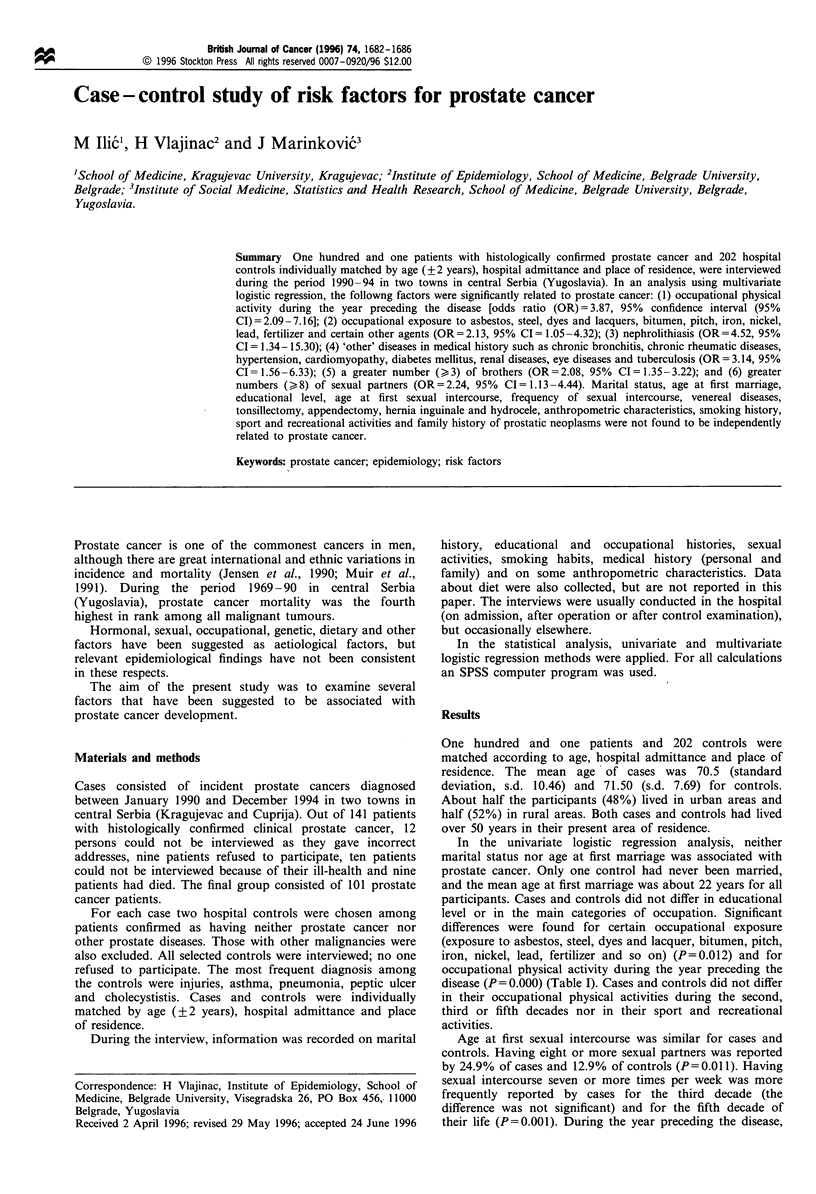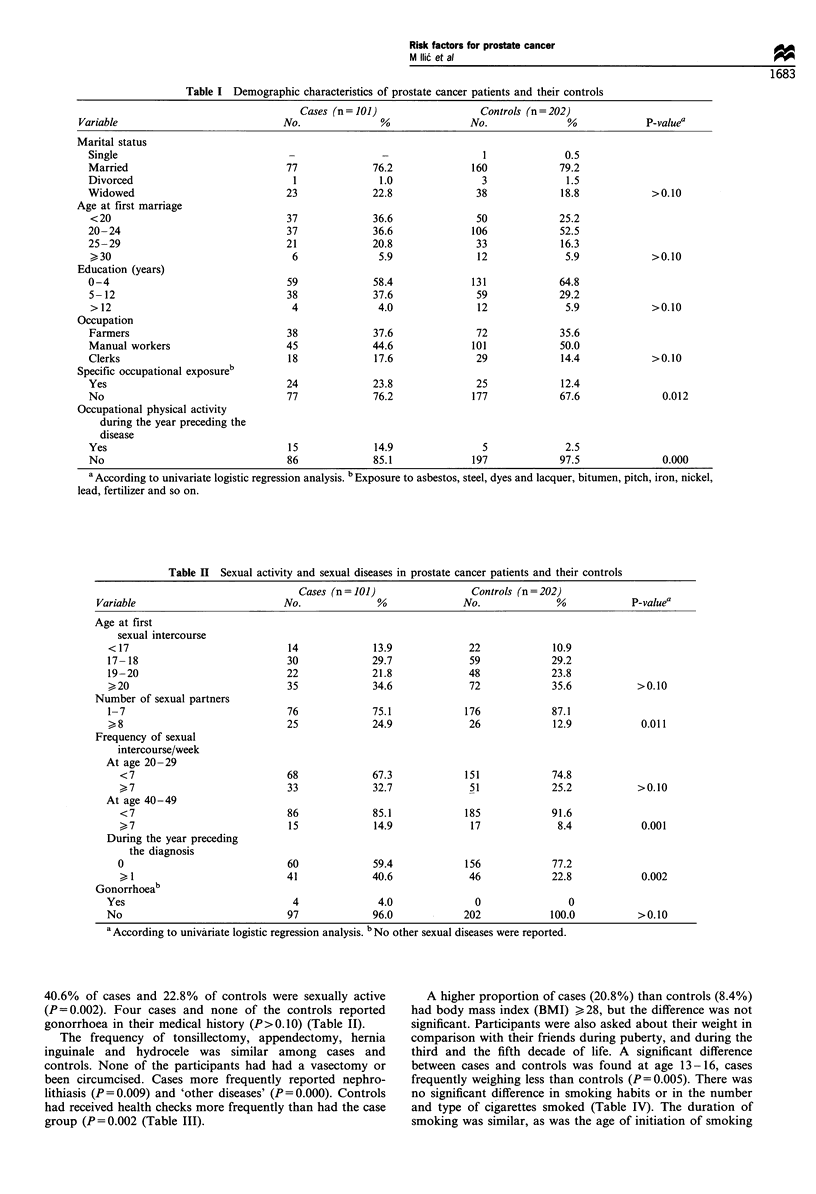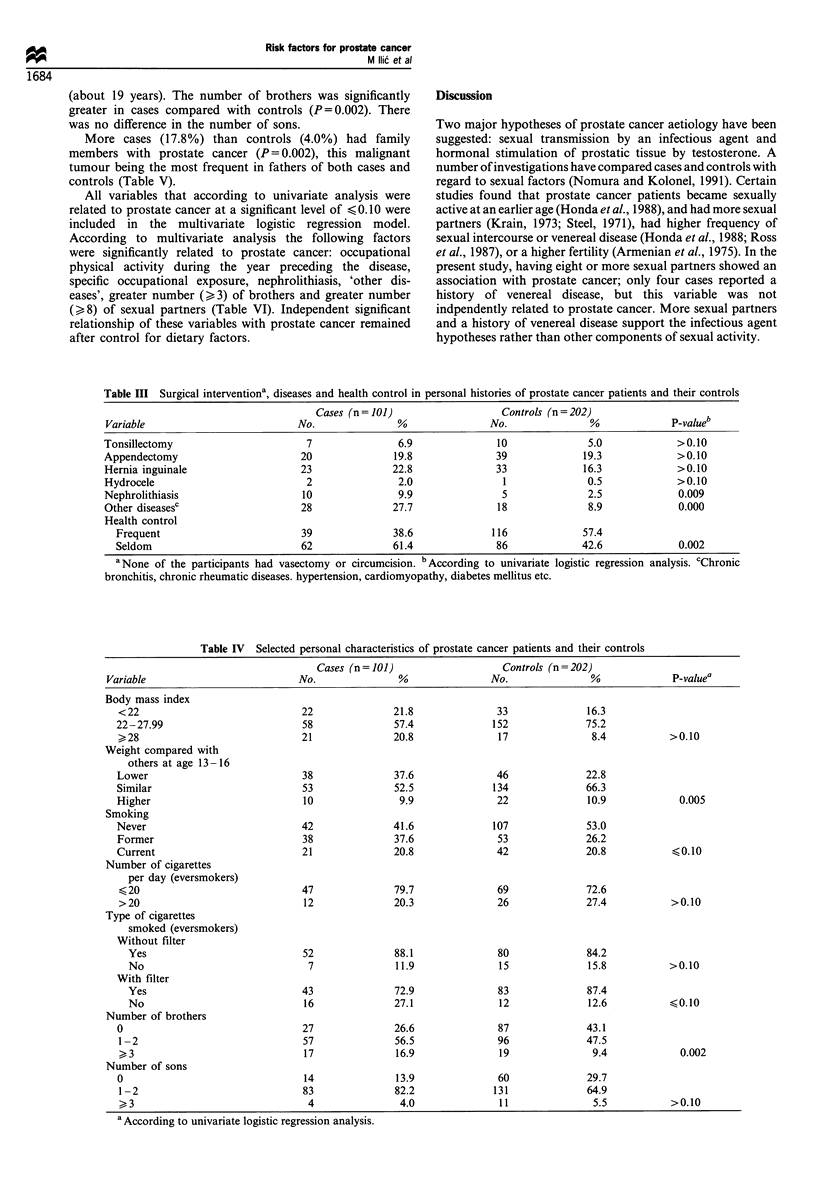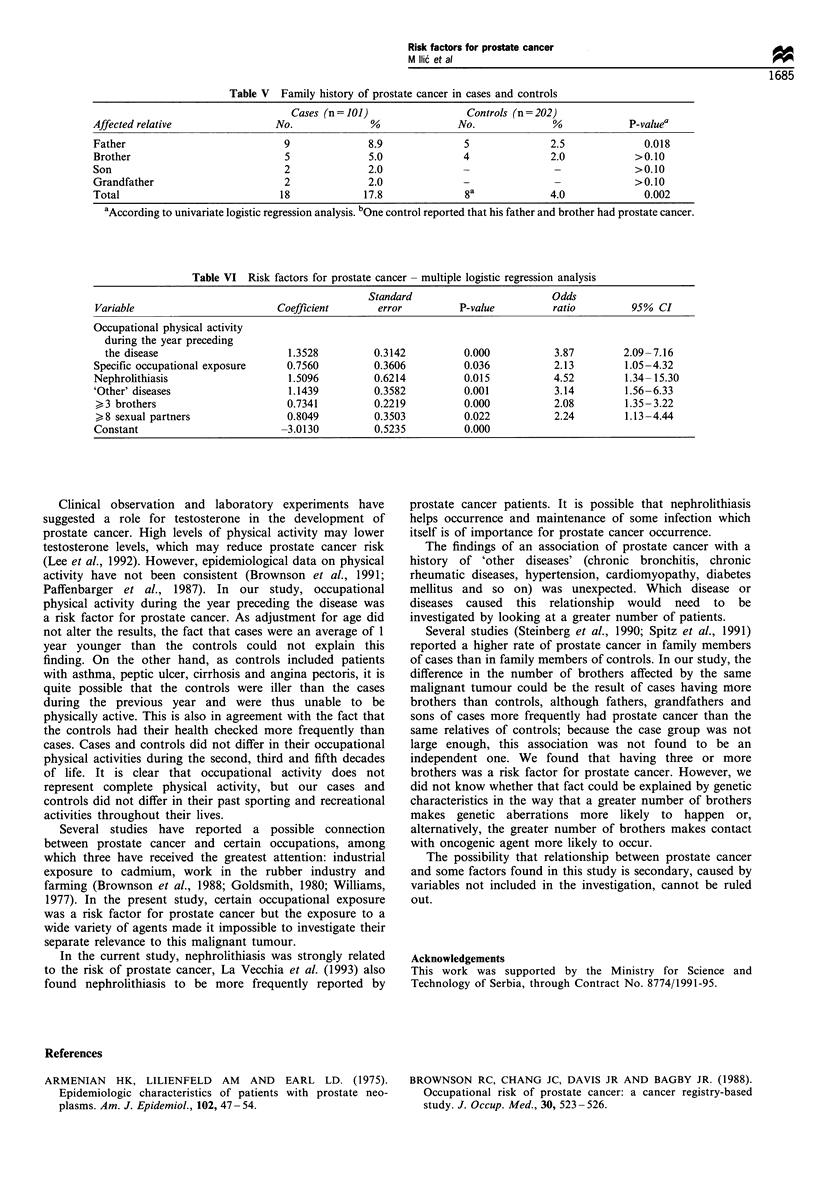Abstract
One hundred and one patients with histologically confirmed prostate cancer and 202 hospital controls individually matched by age (+/- 2 years), hospital admittance and place of residence, were interviewed during the period 1990-94 in two towns in central Serbia (Yugoslavia). In an analysis using multivariate logistic regression, the followng factors were significantly related to prostate cancer: (1) occupational physical activity during the year preceding the disease [odds ratio (OR)=3.87, 95% confidence interval (95% CI)=2.09-7.16]; (2) occupational exposure to asbestos, steel, dyes and lacquers, bitumen, pitch, iron, nickel, lead, fertilizer and certain other agents (OR=2.13, 95% CI=1.05-4.32); (3) nephrolithiasis (OR=4.52, 95% CI=1.34-15.30); (4) 'other' diseases in medical history such as chronic bronchitis, chronic rheumatic diseases, hypertension, cardiomyopathy, diabetes mellitus, renal diseases, eye diseases and tuberculosis (OR=3.14, 95% CI=1.56-6.33); (5) a greater number (> or = 3) of brothers (OR=2.08, 95% CI=1.35-3.22); and (6) greater numbers (> or = 8) of sexual partners (OR=2.24, 95% CI=1.13-4.44). Marital status, age at first marriage, educational level, age at first sexual intercourse, frequency of sexual intercourse, venereal diseases, tonsillectomy, appendectomy, hernia inguinale and hydrocele, anthropometric characteristics, smoking history, sport and recreational activities and family history of prostatic neoplasms were not found to be independently related to prostate cancer.
Full text
PDF




Selected References
These references are in PubMed. This may not be the complete list of references from this article.
- Armenian H. K., Lilienfeld A. M., Diamond E. L., Bross I. D. Epidemiologic characteristics of patients with prostatic neoplasms. Am J Epidemiol. 1975 Jul;102(1):47–54. doi: 10.1093/oxfordjournals.aje.a112133. [DOI] [PubMed] [Google Scholar]
- Brownson R. C., Chang J. C., Davis J. R., Bagby J. R., Jr Occupational risk of prostate cancer: a cancer registry-based study. J Occup Med. 1988 Jun;30(6):523–526. [PubMed] [Google Scholar]
- Brownson R. C., Chang J. C., Davis J. R., Smith C. A. Physical activity on the job and cancer in Missouri. Am J Public Health. 1991 May;81(5):639–642. doi: 10.2105/ajph.81.5.639. [DOI] [PMC free article] [PubMed] [Google Scholar]
- Honda G. D., Bernstein L., Ross R. K., Greenland S., Gerkins V., Henderson B. E. Vasectomy, cigarette smoking, and age at first sexual intercourse as risk factors for prostate cancer in middle-aged men. Br J Cancer. 1988 Mar;57(3):326–331. doi: 10.1038/bjc.1988.74. [DOI] [PMC free article] [PubMed] [Google Scholar]
- Jensen O. M., Estève J., Møller H., Renard H. Cancer in the European Community and its member states. Eur J Cancer. 1990;26(11-12):1167–1256. doi: 10.1016/0277-5379(90)90278-2. [DOI] [PubMed] [Google Scholar]
- La Vecchia C., Franceschi S., Talamini R., Negri E., Boyle P., D'Avanzo B. Marital status, indicators of sexual activity and prostatic cancer. J Epidemiol Community Health. 1993 Dec;47(6):450–453. doi: 10.1136/jech.47.6.450. [DOI] [PMC free article] [PubMed] [Google Scholar]
- Lee I. M., Paffenbarger R. S., Jr, Hsieh C. C. Physical activity and risk of prostatic cancer among college alumni. Am J Epidemiol. 1992 Jan 15;135(2):169–179. doi: 10.1093/oxfordjournals.aje.a116269. [DOI] [PubMed] [Google Scholar]
- Muir C. S., Nectoux J., Staszewski J. The epidemiology of prostatic cancer. Geographical distribution and time-trends. Acta Oncol. 1991;30(2):133–140. doi: 10.3109/02841869109092336. [DOI] [PubMed] [Google Scholar]
- Nomura A. M., Kolonel L. N. Prostate cancer: a current perspective. Epidemiol Rev. 1991;13:200–227. doi: 10.1093/oxfordjournals.epirev.a036069. [DOI] [PubMed] [Google Scholar]
- Paffenbarger R. S., Jr, Hyde R. T., Wing A. L. Physical activity and incidence of cancer in diverse populations: a preliminary report. Am J Clin Nutr. 1987 Jan;45(1 Suppl):312–317. doi: 10.1093/ajcn/45.1.312. [DOI] [PubMed] [Google Scholar]
- Ross R. K., Shimizu H., Paganini-Hill A., Honda G., Henderson B. E. Case-control studies of prostate cancer in blacks and whites in southern California. J Natl Cancer Inst. 1987 May;78(5):869–874. [PubMed] [Google Scholar]
- Spitz M. R., Currier R. D., Fueger J. J., Babaian R. J., Newell G. R. Familial patterns of prostate cancer: a case-control analysis. J Urol. 1991 Nov;146(5):1305–1307. doi: 10.1016/s0022-5347(17)38074-6. [DOI] [PubMed] [Google Scholar]
- Steinberg G. D., Carter B. S., Beaty T. H., Childs B., Walsh P. C. Family history and the risk of prostate cancer. Prostate. 1990;17(4):337–347. doi: 10.1002/pros.2990170409. [DOI] [PubMed] [Google Scholar]
- Williams R. R., Stegens N. L., Goldsmith J. R. Associations of cancer site and type with occupation and industry from the Third National Cancer Survey Interview. J Natl Cancer Inst. 1977 Oct;59(4):1147–1185. doi: 10.1093/jnci/59.4.1147. [DOI] [PubMed] [Google Scholar]


